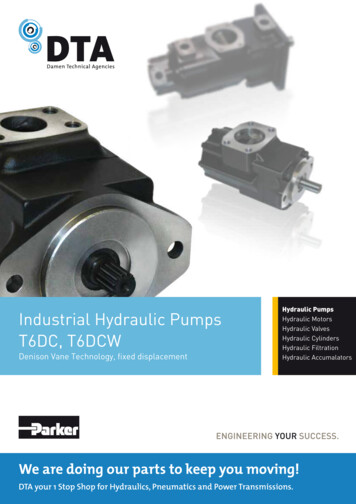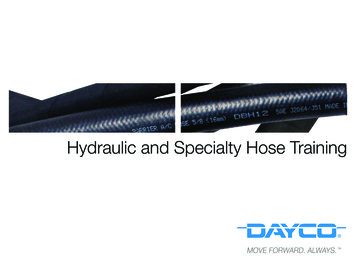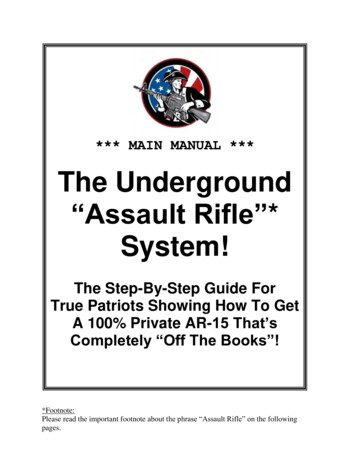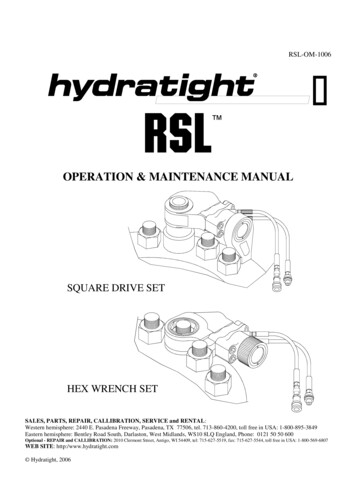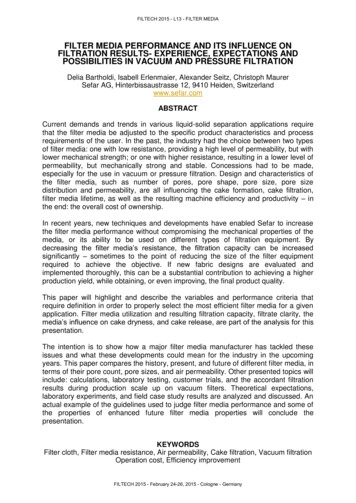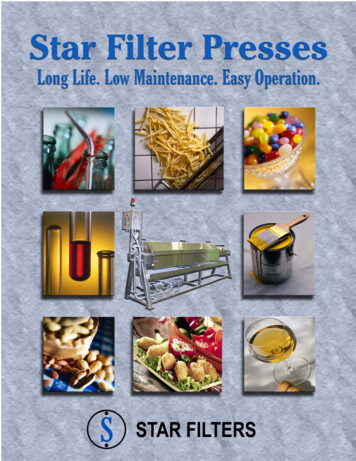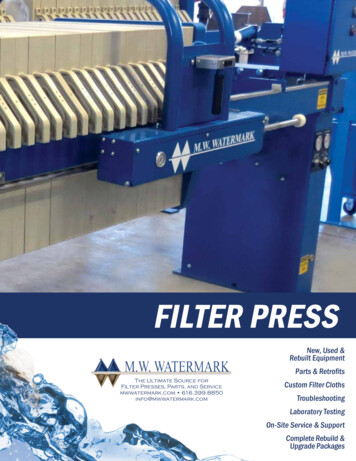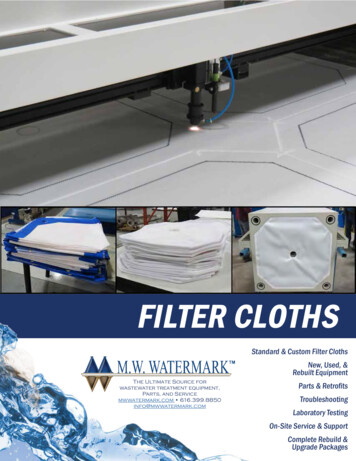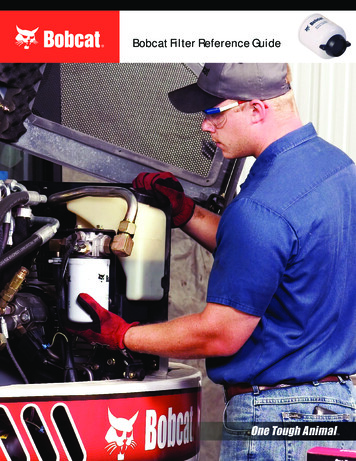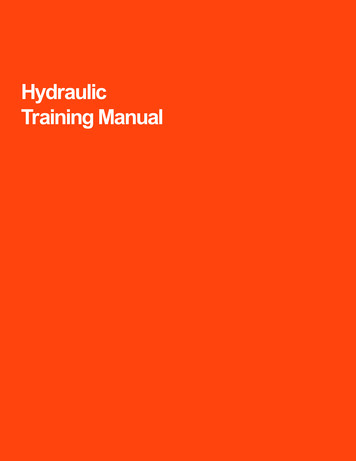
Transcription
HydraulicTraining Manual
Arranged and produced by
ContentsDefinition of HydraulicsIntroduction to HydraulicsDesigning a Simple Hydraulic CircuitPrinciples of HydraulicsContaminationSources of ContaminationThe Effects of ContaminationThe Costs of ContaminationComparison of Filter Types and LocationsFilter Test MethodsRating a Filter
Definition of HydraulicsHydraulics is a branch of science and engineeringconcerned with the use of fluids to performmechanical tasks. It is part of the more generaldiscipline of fluid power.The word "hydraulics" comes from the Greek wordhydraulikos which means water organ which in turnmeans water and pipe.Typically, the fluid used in a hydraulic system is anincompressible liquid such as a mineral basedhydraulic oil. Pressure is applied by a piston to fluidin a cylinder, causing the fluid to press on anotherpiston that delivers energy to a load. If the areas ofthe two pistons are different, then the force appliedto the first piston will be different from the forceexerted by the second piston.This creates a mechanical advantage.Pascal’s LawA change in pressure at any point in an enclosed fluid at rest istransmitted undiminished to all points in the fluid.This principle is stated mathematically as:ΔP v(Δh)
Introduction to HydraulicsA hydraulic system is not a source of power.The power source would be a prime mover such as an electric engine which drives the pump.Advantages of Hydraulics Variable Speed: The actuator (A device forconverting energy into mechanical energyi.e., a motor or cylinder.) in a hydraulic systemcan be driven at different speeds. Reversible: A hydraulic actuator can bereversed instantly while in full motionwithout damage. Overload Protection: The pressure relief valvein a hydraulic system protects the system fromoverload damage. Small Components: Hydraulic components,because of their high speed and pressurecapabilities, can provide high power output withvery small weight and size. Can Be Stalled: A hydraulic actuator can bestalled without damage when overloaded,and will start up immediately when the loadis reduced. Hydraulic Oil: The oil transmits power readilysince it is minimally compressible. The mostdesirable property of the oil is itslubricating ability.
Basic hydraulic system with a linearhydraulic actuator.ABCDEFGHReservoirElectric MotorPumpMaximum Pressure Relief ValveDirectional ValveFlow Control ValveRight-angle Check ValveCylinder
Designing a SimpleHydraulic Circuit1. All circuit design must start with the job you want toachieve. For example; a weight to be lifted,a tool head to be rotated, or piece of work that mustbe clamped.2. If the requirement were simply to raise a load, placinga hydraulic cylinder under it would do the job. Thestroke length of the cylinder would have to be at leastequal to the distance the load must be moved.3. The cylinder’s area would be determined by the forcerequired to raise the load and the desired operatingpressure. For example; if an 8000 lb weight is to beraised a distance of 30 inches and the maximumoperating pressure must be limited to 1000 psi thenthe cylinder selected would require a stroke lengthof at least 30 inches and with an 8 in 2 area piston itwould provide a maximum force of 8000 lbs. Howeverthis, would not provide any margin for error.
To raise an 8000 lb load 30 inches,a cylinder with at least a 30 inch strokeis required.
Designing a SimpleHydraulic CircuitContinuedThe better selection would be a 10 in 2 cylinder permittingthe load to be raised at 800 psi and providing thecapability of lifting up to 10,000 lbs.The upward and downward travel of the piston rod wouldbe controlled by a directional valve. The rate at which theload must travel will determine the pump size. The 10 in 2piston will displace 10 in 3 for every inch it lifts. Extendingthe piston rod 30 inches will require 300 in 3 of fluid. If itis to move at a rate of 10 inches per second, it will require100 in3 of fluid per second or 6000 in3 per minute. Sincepumps are usually rated in gallons per minute, thefollowing conversion is necessary:6000 23126 gpm
The minimum pressure required tolift the load equals the load dividedby the piston area. In this case 10square inches.8000lbs 10 sq in800 psiTherefore 800psi minimum isneeded to lift our load of 8000lbs.
Designing a SimpleHydraulic CircuitContinuedThe horsepower (hp) needed to drive the pump is afunction of its delivery and the maximum pressure atwhich it may operate. The following formula examplewill determine the size of the motor required:hp gpm x psi x 0.0007hp 26 x 1000 x 0.0007hp 18.2To prevent overloading of the motor and to protect thepump and other components from excessive pressuredue to overloads or stalling, a relief valve should be setto limit the maximum system pressure and installed in theline between the pump outlet and the pump inlet port tothe directional valve (as shown in the adjacent diagram).A reservoir sized to hold approximately two to three timesthe pump capacity in gallons per minute, filters, andadequate piping would complete the system
Piston Rod ExtendsThe relief valveprotects thesystem from overpressure bydiverting the pumpflow to tank whenthe maximumpressure settingis reached.Electric MotorPump delivery isdirected to the capend of the cylinderRelief ValveExhaust oil ispushed out of therod end and back tothe tank.Directional ValveFlow indicated byswitch position.Pump
Principles of HydraulicsHow Pressure is Created.Pressure results whenever there is resistance tofluid flow or to a force which attempts to make thefluid flow. The tendency to cause flow (or the push)may be supplied by a mechanical pump or may becaused simply by the weight of the fluid.It is well known that pressure increases with depth ina body of water. The pressure is always equal at anyparticular depth due to the weight of the water aboveit. An Italian scientist named Torricelli proved that ifa hole is made in the bottom of a tank of water, thewater runs out faster when the tank is full and theflow rate decreases as the water level lowers.In other words, as the “head” of water above theopening lessens, so does the pressure.Torricelli expressed that the pressure at the bottomof the tank only as “feet of head”, or the height in feetof the column of water. Today, with the pound persquare inch (psi) as a unit pressure, we can expresspressure anywhere in any liquid in more convenientterms.All that is required is knowing how much a cubic footof the fluid weighs.
Then the total weight is624 lbs. This weight isdivided over 144 squareinches. This gives us apressure of 4.33 psi at thebottom of the 10 footcolumn of water.
Principles of HydraulicsContinuedPrinciples of FlowFlow is the action in the hydraulic system that givesthe actuator its motion. Pressure gives the actuatorits force, but flow is essential to cause movement.Flow in the hydraulic system is created by the pump.How Flow is MeasuredThere are two ways to measure the flow of a fluid: Velocity is the average speed of the fluid’sparticles past a given point or the averagedistance the particles travel per unit of time. It isusually measured in feet per second (fps), feetper minute (fpm), or inches per second (ips). Flow rate is a measure of the volume of fluidpassing a point in a given time. Large volumesare measured in gallons per minute (gpm).Small volumes may be expressed in cubicinches per minute.Bellow illustrates the distinction betweenvelocity and flow rate. A constant flow of one gallonper minute either increases or decreases in velocitywhen the cross section of the pipe changes size.
Flow Rate and SpeedThe speed of a hydraulic actuator, always dependson the actuator’s size and the rate of flow into it.Since the size of the actuator will generally beexpressed in cubic inches, use thisconversion factor:gpm in3/minute231Flow Rate and Pressure DropWhenever a liquid is flowing, there must be acondition of unbalanced force to cause motion.Therefore, when a fluid flows through a constantdiameter pipe, the pressure will always beslightly lower downstream with reference to any pointupstream. This difference in pressure, or pressuredrop, is required to overcome friction in the line.Fluid Seeks a LevelConversely, when there is no pressure differenceon a liquid, it simply seeks a level. If the pressurechanges at one point the liquid levels at theother points only rise until their weight is sufficient tomake up the difference in pressure. The differencein height (head) in the case of oil is one foot per 0.4psi. Thus it can be seen that additional pressuredifference will be required to cause a liquid to flowup a pipe or to lift the fluid since the force (due to theweight of the liquid) must be overcome.In circuit design, naturally, the pressure required tomove the oil mass and to overcome friction mustbe added to the pressure needed to move the load.In most applications, good design minimizes thesepressure “drops” to the point where they becomealmost negligible.
ContaminationThere is a consensus that 70% to 90% of equipmentwear and failure is attributed to contamination. Solidparticles, such as dirt, are the chief culprits becauseof their ability to directly attack metal surfaces. Theselection of a High quality filter is a cost effectiveway of reducing this contaminate. All hydraulic fluidscontain dirt to some degree. Dirt in hydraulic fluidis the downfall of even the best designed hydraulicsystems. Dirt particles can bring huge and expensivemachinery to its knees.Dirt vs Hydraulic FluidDirt causes trouble in a hydraulic system because itinterferes with the fluid which has four functions:1. To act as a medium for energy transmission2. To lubricate internal moving parts of hydrauliccomponents3. To act as a heat transfer medium4. To seal clearances between close fitting movingpartsDirt interferes with the transmission of energy byplugging small orifices in hydraulic componentslike pressure valves and flow control valves. In thiscondition pressure has a difficult time passing to theother side of the spool. The valve’s action is not onlyunpredictable and nonproductive, but unsafe.Because of viscosity, friction, and changing direction,hydraulic fluid generates heat during systemoperation. When the fluid returns to the reservoir, itgives the heat up to the reservoir walls.Dirt particles interfere with liquid cooling by forming asludge which makes heat transfer to reservoirwalls difficult.
Clean hydraulic systems run cooler than dirtysystems. Probably the greatest problem with dirt in ahydraulic system is that it interferes with lubrication.Dirt can be divided into three sizes with respect to aparticular component’s clearances; that is, dirt whichis smaller than a clearance, dirt which is the samesize, and dirt which is larger than a clearance.Extremely fine dirt, which is smaller than acomponent’s clearances, can collect inclearances especially if there are excessive amountsand the valve is not operated frequently. This blocksor obstructs lubricative flow through the passage.An accumulation of extremely fine dirt particles in ahydraulic system is known as silting.Dirt which is about the same size as a clearancerubs against moving parts breaking down a fluid’slubricative film. Large dirt can also interfere withlubrication by collecting at the entrance and blockingfluid flow between moving parts.A lack of lubrication causes excessive wear, slowresponse, erratic operation, solenoid burn out, andearly component failure.Dirt is PollutionDirt in a hydraulic system is pollution. It is verysimilar to bottles, cans, paper and old tires floatingin your favorite river or stream. The difference is thathydraulic system pollution is measured using a verysmall scale. The micrometer scale is used tomeasure dirt in hydraulic systems.
Sources of ContaminationWhen engineering a complex hydraulic system,designers must consider the ways in whichcontaminants reach the fluid, as well as the quantityand size of the particles. Those factors influence thesize, micron rating, and location of filters.Built-In or From MaintenanceDuring manufacturing or maintenance, largequantities of particles and solid debris areintroduced. Even the most thorough flushing doesn’teliminate all foreign matter, some of which dislodgesonce the system is put into operation. Also, there isno guarantee that all of the right procedures will befollowed, so, as equipment can sustain significantwear in the first few days after start-up, high qualityfiltration is essential at this stage.Tank LeakageLoose inspection plates and other unsealed joints ina tank allow a great deal of dirt into the fluid,particularly when surrounding air is polluted.Air Through BreatherMost hydraulic systems draw in and expel air as theoil level in the reservoir changes. Often, this is amain source of dirt ingestion, especially when filterbreathers either are not installed or maintained.Dirty OilNew oil is seldom as clean as required for amodern hydraulic system, even when it is describedas “clean” by the supplier. When stored improperlyor not well filtered before filling the reservoir, it likelywill be many times as contaminated as the systemcan tolerate.
Pump WearPumps, especially when worn, are a key source ofmetal wear particles. Hard wear metals are of greatconcern for several reasons:1. Potential for damage to valves, cylinders andmotors immediately downstream.2. Ability to generate large numbers of additionalparticles within the system.3. Action as a catalyst in the fluid oxidation process.Piping SlagOlder pipes can flake off quantities of largerparticles, such as scale, rust and welding slag.Dirt on Cylinder RodsWhen sliding back and forth, cylinder rods can drawin large quantities of smaller particles, depending onthe concentration of airborne dirt and quality of therod seals. This is a particular problem in systemswith numerous large cylinders.System De
Training Manual. Arranged and produced by. Definition of Hydraulics Introduction to Hydraulics Designing a Simple Hydraulic Circuit Principles of Hydraulics Contamination Sources of Contamination The Effects of Contamination The Costs of Contamination Comparison of Filter Types and Locations Filter Test Methods Rating a Filter Contents. Hydraulics is a branch of science and engineering .
